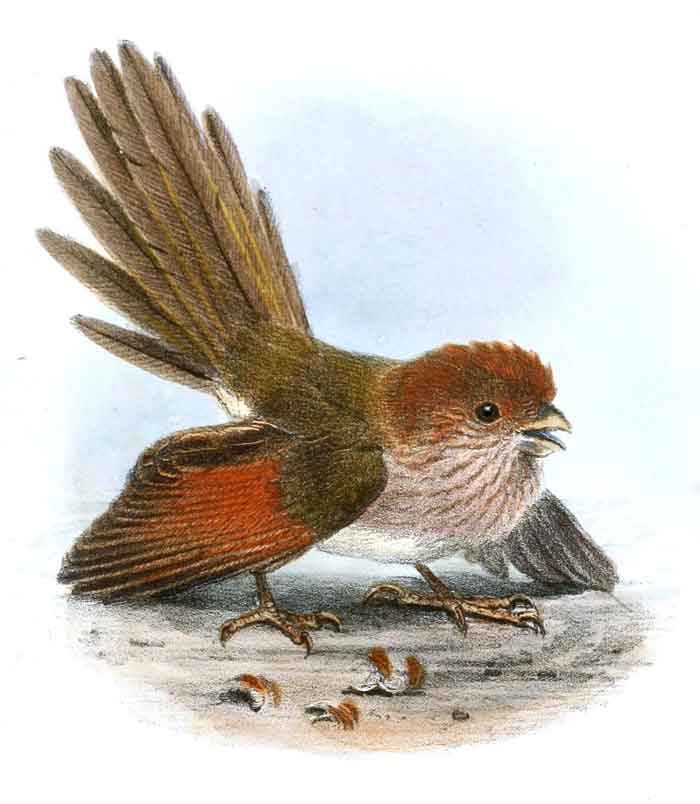
Paradoxornis webbianus (Information about this image)
Superregnum: Eukaryota
Cladus: Unikonta
Cladus: Opisthokonta
Cladus: Holozoa
Regnum: Animalia
Subregnum: Eumetazoa
Cladus: Bilateria
Cladus: Nephrozoa
Superphylum: Deuterostomia
Phylum: Chordata
Subphylum: Vertebrata
Infraphylum: Gnathostomata
Megaclassis: Osteichthyes
Cladus: Sarcopterygii
Cladus: Rhipidistia
Cladus: Tetrapodomorpha
Cladus: Eotetrapodiformes
Cladus: Elpistostegalia
Superclassis: Tetrapoda
Cladus: Reptiliomorpha
Cladus: Amniota
Classis: Reptilia
Cladus: Eureptilia
Cladus: Romeriida
Subclassis: Diapsida
Cladus: Sauria
Infraclassis: Archosauromorpha
Cladus: Crurotarsi
Divisio: Archosauria
Cladus: Avemetatarsalia
Cladus: Ornithodira
Subtaxon: Dinosauromorpha
Cladus: Dinosauriformes
Cladus: Dracohors
Cladus: Dinosauria
Cladus: Saurischia
Cladus: Eusaurischia
Subordo: Theropoda
Cladus: Neotheropoda
Cladus: Averostra
Cladus: Tetanurae
Cladus: Avetheropoda
Cladus: Coelurosauria
Cladus: Tyrannoraptora
Cladus: Maniraptoromorpha
Cladus: Maniraptoriformes
Cladus: Maniraptora
Cladus: Pennaraptora
Cladus: Paraves
Cladus: Eumaniraptora
Cladus: Avialae
Infraclassis: Aves
Cladus: Avebrevicauda
Cladus: Pygostylia
Cladus: Ornithothoraces
Cladus: Ornithuromorpha
Cladus: Carinatae
Parvclassis: Neornithes
Cohors: Neognathae
Cladus: Neoaves
Cladus: Telluraves
Cladus: Australaves
Ordo: Passeriformes
Subordo: Passeri
Infraordo: Passerida
Superfamilia: Sylvioidea
Familia: Paradoxornithidae
Genus: Suthora
Species: Suthora webbiana
Subspecies: S. w. bulomacha – S. w. elisabethae – S. w. fulvicauda – S. w. mantschurica – S. w. suffusa – S. w. webbiana
Name
Suthora webbiana Gould, 1852
Synonymy
Sinosuthora webbiana
Paradoxornis webbianus
References
The Birds of Asia 3 (4): pl.72, un-numbered page.
Vernacular names
Cymraeg: Gylfindro gyddfwinau
Deutsch: Braunkopf-Papageischnabel
English: Vinous-throated Parrotbill
Esperanto: Violgorĝa paradoksornito
español: Picoloro de Webb
فارسی: طوطیمنقاری گلوانگوری
日本語: ダルマエナガ
한국어: 붉은머리오목눈이
Nederlands: Bruinkopdiksnavelmees
русский: Бурая сутора
svenska: Rosenpapegojnäbb
Tiếng Việt: Khướu mỏ dẹt bé
中文: 棕头鸦雀

The vinous-throated parrotbill (Suthora webbiana) is a species of parrotbill in the family Paradoxornithidae; formerly, it was placed in the closely related Sylviidae or Timaliidae. It is found in China, Japan, Korea, Mongolia, Russia, Taiwan, and Vietnam. Its natural habitat is subtropical or tropical moist montane forests.
Taxonomy and systematics
Illustration by Joseph Wolf (1866)
The vinous-throated parrotbill was described in 1852 by John Gould and placed in the genus Suthora, where it sat with other small browner parrotbills. Later parrotbills were merged into two genera, Conostoma and Paradoxornis; with this species being placed in Paradoxornis. Recent DNA studies have shown that the genus Paradoxornis is paraphyletic, and that it should be split. It is suggested that the vinous-throated parrotbill should be placed in the genus Sinosuthora. The vinous-throated parrotbill is very closely related to the ashy-throated parrotbill, and hybrids have been reported between the two species in Vietnam and China, as well as in Italy where both species have become established.[2] It is now placed in its original genus, the Suthora in International Ornithologists' Union bird list 13.2.[3]
The specific name webbiana commemorates the English botanist Philip Barker Webb. The species is sometimes referred to as Webb's parrotbill.[4]
Habitat and movements
The vinous-throated parrotbill occurs from northern Vietnam to southern Manchuria, and occupies a wide range of habitats across its range. It is generally found in somewhat open wooded habitats, including scrub, woodland of early successional to late mature secondary stages, forest edges, thickets and bamboo stands. It also occurs in hedges, reeds and marshes. They also will adapt to human modified habitats such as tea plantations and plant nurseries. In China it is found in lower montane areas. In Sichuan it is replaced at 1,000 m (3,300 ft) above sea level by the ashy-throated parrotbill, whereas in Taiwan, where it is the only species of parrotbill, it occurs from sea level to 3,100 m (10,200 ft) and occupies the widest niche of any bird on that island.[5]
Description
The vinous-throated parrotbill is a relatively small and long-tailed parrotbill. It measures between 11 and 12.5 cm (4.3–4.9 in) in length. The weight varies slightly by sex, with males weighing between 8.5 to 11 g (0.30–0.39 oz) and the females weighing 7 to 12 g (0.25–0.42 oz)[verification needed]. The tail is graduated and like other parrotbills the bill is short and has the nostrils concealed by feather bristles. The plumage is similar for both sexes, which in the nominate is warm brown on the upperparts, dark brown on the wings (tinged with chestnut on the flight feathers). The upper breast and throat are pinkish-cream with brown streaks on the throat. The flanks are similar to the upperparts but slightly buffy, and the belly is cream-buff merging into the breast. The crown and forehead are rufescent brown, with a pale grey iris and the bill is either slate grey or brown with a paler or yellow tip.
Behaviour
Like other parrotbills and indeed related babblers, the vinous-throated parrotbill is a highly social species, usually encountered in groups. These flocks vary in size through the year, being at their smallest during the breeding season and increasing to as many as 140 individual birds in the winter. The members of winter flocks in Taiwan were described by a study as having four categories of member: core members, which never left the flock; regular members, which generally stayed in the flock but visited or briefly joined other flocks; floaters, which moved around between flocks; and peripheral members, which were only seen for less than two months and were assumed to be visitors from other areas. The ranges of large winter flocks can overlap with that of other flocks and flocks passing close together retain their cohesion.
References
BirdLife International (2018). "Sinosuthora webbiana". IUCN Red List of Threatened Species. 2018: e.T22716804A132113206. doi:10.2305/IUCN.UK.2018-2.RLTS.T22716804A132113206.en. Retrieved 11 November 2021.
Boto, Alberto, Andrea Galimberti and Richard Bonser (2009) The parrotbills in Lombardia, Italy Birding World 22(11):471-474.
Gill, F; Donsker, D; Rasmussen, P, eds. (2023). IOC World Bird List (v 13.2). doi:10.14344/IOC.ML.13.2.
Beolens, Bo; Watkins, Michael (2004). Whose Bird?: Common Bird Names and the People They Commemorate. Yale University Press. p. 361. ISBN 978-0-300-10359-5.
Robson, Craig (2007). "Family Paradoxornithidae (Parrotbill)". In del Hoyo, Josep; Elliott, Andrew; Christie, David (eds.). Handbook of the Birds of the World. Volume 12: Picathartes to Tits and Chickadees. Barcelona: Lynx Edicions. pp. 292–320. ISBN 978-84-96553-42-2.
Retrieved from "http://en.wikipedia.org/"
All text is available under the terms of the GNU Free Documentation License

